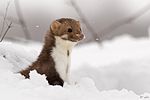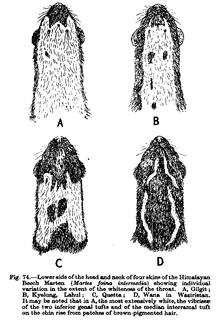- Beech Marten
-
Beech Marten 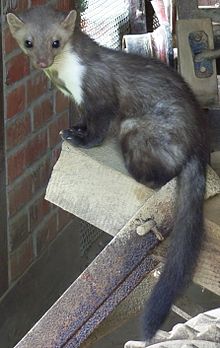
Conservation status Scientific classification Kingdom: Animalia Phylum: Chordata Class: Mammalia Order: Carnivora Family: Mustelidae Genus: Martes Species: M. foina Binomial name Martes foina
(Erxleben, 1777)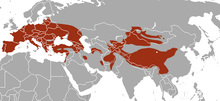
Beech Marten range The Beech Marten (Martes foina), also known as the Stone Marten or White Breasted Marten, is a species of marten native to much of Europe and Central Asia, though it has established a feral population in North America. It is listed as Least Concern by the IUCN on account of its wide distribution, its large population and its presence in a number of protected areas.[1] It is superficially similar to the pine marten, but differs from it by its smaller size and habitat preferences ; while the pine marten is a forest specialist, the beech marten is a more generalist and adaptable species, occurring in a number of open and forest habitats.[2]
Contents
Evolution
Its most likely ancestor is Martes vetus, which also gave rise to the pine marten. The earliest M. vetus fossils were found in deposists dated to the Würm glaciation in Lebanon and Israel. The beech marten likely originated in the Near East or southwestern Asia, and may have arrived in Europe by the Late Pleistocene or the early Holocene. Thus, the beech marten differs from most other European mustelids of the Quaternary, as all other species (save for the European mink) appeared during the Middle Pleistocene. Comparisons between fossil animals and their descendants indicate that the beech marten underwent a decrease in size beginning in the Würm period.[3] Beech martens indigenous to the Aegean Islands represent a relic population with primitive Asiatic affinities.[4]
The skull of the beech marten suggests a higher adaptation than the pine marten toward hypercarnivory, as indicated by its smaller head, shorter snout and its narrower post-orbital constriction and lesser emphasis on cheek teeth. Selective pressures must have acted to increase the beech marten's bite force at the expense of gape. These traits probably acted on male beech martens as a mechanism to avoid both intraspecific competition with females and interspecific competition with the ecologically overlapping pine marten.[2]
Subspecies
As of 2005[update],[5] eleven subspecies are recognised.
Subspecies Trinomial authority Description Range Synonyms European beech marten
Martes f. foinaErxleben, 1777 A small subspecies, with an average-szied skull. In winter, its back varies from light greyish tawny to completely dark brown. The guard hairs are tawny or chestnut brown, while the underfur is very light, pale-grey. The flanks and withers are slightly lighter than the back, and the belly darker. The legs are dark brown and the throat patch pure white. The patch is variable in size and shape.[6] European Russia, Western Europe (except the Balkan Peninsula) and the Iberian Peninsula alba (Bechstein, 1801)
domestica (Pinel, 1792)
fagorum (Fatio, 1869)Balkan beech marten
Martes f. bosniacaBrass, 1911 Balkan Peninsula Cretan beech marten
Martes f. bunitesBate, 1906 A smaller subspecies than foina, with a less defined throat patch, which may be absent in some specimens.[7] Crete, Skopelos, Naxos, Erimomilos, Karpathos, Samothrake, Seriphos and Kythnos Middle Asian beech marten
Martes f. intermediaSevertzov, 1873 A smaller subspecies than nehringi, with lighter fur. The back is moderately dark greyish-tawny. The flanks are lighter, but of the same tone as the back. The guard hairs are dark-tawny, while the underfur is almost white. The tail is dark brown. The throat patch is very variable, being sometimes completely undefined.[8] Montane Middle Asia, from Kopet Dag and Bolshoi Balkhas to Tarbagatai and Altai. Outside the former Soviet Union, its range includes northern Iran, Afghanistan, western Pakistan, western Himalayas, Tien Shan, Tibet and northern Mongolia altaica (Satunin, 1914)
leucolachnaea (Blanford, 1879)
Tibetan beech marten
Martes f. kozloviOgnev, 1931 Eastern Tibet Iberian beech marten
Martes f. mediterraneaBarrett-Hamilton, 1898. A lighter, less drab coloured form than foina.[9] Iberian Peninsula Rhodes beech marten
Martes f. milleriFesta, 1914 Rhodes Caucasian beech marten
Martes f. nehringiSatunin, 1906 A large subspecies with a massive skull. The winter coat is quite dark, brownish-tawny or dark tawny with a greyish tint. The flanks are lighter than the back, and the tail and feet are dark brown. The throat patch varies in form and size, but shows a tendency towards reduction.[10] Caucasus and continguous parts of Turkey and Iran Crimean beech marten
Martes f. rosanowiMartino and Martino, 1917 A smaller subspecies than foina, but with near identical colours.[10] Montane Crimea Syrian beech marten
Martes f. syriacaNehring, 1902 A pale coloured subspecies with a smaller skull than the nominative form[11] Syria Lhasa beech marten
Martes f. toufoeusHodgson, 1842 Lhasa, Tibet Description
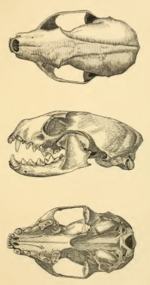 Skull, as illustrated in Merriam's Synopsis of the weasels of North America
Skull, as illustrated in Merriam's Synopsis of the weasels of North America
The beech marten is superficially similar to the pine marten, but has a somewhat longer tail, a more elongated and angular head and has shorter, more rounded and widely spaced ears. Its nose is also of a light peach or grey colour, whereas that of the pine marten is dark black or greyish-black.[12] Its feet are not as densely furred as those of the pine marten, thus making them look less broad, with the paw pads remaining visible even in winter. Because of its shorter limbs, the beech marten's manner of locomotion differs from that of the pine marten ; the beech marten moves by creeping in a polecat-like manner, whereas the pine marten and sable move by bounds.[13] The weight load per 1 cm2 of the supporting surface of the beech marten's foot (30.9 gm) is double that of the pine marten (15.2 gm), thus it is obliged to avoid snowy regions.[14]
Its skull is similar to that of the pine marten, but differs in its shorter facial region, more convex profile, its larger carnassials and smaller molars.[15] The beech marten's penis is larger than the pine marten's, with the bacula of young beech martens often outsizing those of old pine martens. Males measure 430-590 mm in body length, while females measure 380-470 mm. The tail measures 250-320 mm in males and 230-275 mm in females. Males weigh 1700-1800 grams in winter and 2000-2100 grams in summer, while females weigh 1100-1300 grams in winter and 1400-1500 grams in summer.[16]
The beech marten's fur is coarser than the pine marten's, with elastic guard hairs and less dense underfur. Its summer coat is short, sparse and coarse, and the tail is sparsely furred. The colour tone is lighter than the pine marten's. Unlike the pine marten, its underfur is whitish, rather than greyish. The tail is dark-brown, while the back is darker than that of the pine marten. The throat patch of the beech marten is always white. The patch is large and generally has two projections extending backwards to the base of the forelegs and upward on the legs. The dark colour of the belly juts out between the forelegs as a line into the white colour of the chest and sometimes into the neck. In the pine marten, by contrast, the white colour between the forelegs juts backwards as a protrusion into the belly colour.[13]
Behaviour
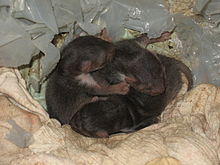 A litter of beech marten kits in а farm outbuilding in the village of Orlintzi, Bulgaria
A litter of beech marten kits in а farm outbuilding in the village of Orlintzi, Bulgaria
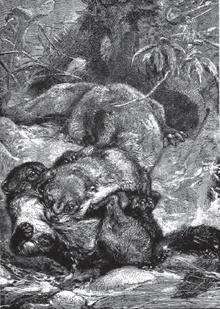 Beech marten fighting a European otter, as illustrated in Brehm's Life of Animals
Beech marten fighting a European otter, as illustrated in Brehm's Life of Animals
The beech marten is mainly a crepuscular and nocturnal animal, though to a much lesser extent than the European polecat. It is especially active during moonlit nights. Being a more terrestrial animal than the pine marten, the beech marten is less arboreal in its habits, though it can be a skilled climber in heavily forested areas. It is a skilled swimmer, and may occasionally be active during daytime hours, particularly in the summer, when nights are short. It typically hunts on the ground. During heavy snowfalls, the beech marten moves through paths made by hares or skis.[17]
Social and territorial behaviours
In an area of northeastern Spain, where the beech marten still lives in relatively unmodified habitats, one specimen was recorded to have had a home range of 52.5 ha (130 acres) with two centres of activity. Its period of maximum activity occurred between 6-12 PM. Between 9-6 PM, the animal was found to be largely inactive.[18] In urban areas, beech martens den almost entirely in buildings, particularly during winter.[19] The beech marten does not dig burrows, nor does it occupy those of other animals. Instead, it nests in naturally occurring fissures and clefts in rocks, spaces between stones in rock slides and inhabited or uninhabited stone structures. It may live in tree holes at a height of up to 9 metres.[20]
Reproduction and development
Estrus and copulation occur at the same time as in the pine marten. Mating occurs in the June-July period, and takes place in the morning or in moonlit nights on the ground or on the roofs of houses. The gestation period lasts as long as the pine marten's, lasting 236-237 days in the wild, and 254-275 days in fur farms. Parturition takes place in late March-early April, with the average litter consisting of 3-7 kits. The kits are born blind, and begin to see at the age of 30-36 days. The lactation period lasts 40-45 days. In early July, the young are indistinguishable from the adults.[21]
Diet
The beech marten's diet includes a much higher quantity of plant food than that of the pine marten and sable. Plant foods eaten by the beech marten include cherries, apples, pears, plums, black nightshade, tomatoes, grapes, raspberries and mountain ash. Plant food typically predominates during the winter months ; one specimen was recorded to have eaten the contents of two dry fruit sacks throughout one winter. Rats and mice are also eaten, and chickens are caught only rarely. Among bird species preyed upon by the beech marten, sparrow-like birds predominate, though snowcocks and partridges may also be taken. Although it rarely attacks poultry, some specimens may become specialised poultry raiders, even when wild prey is abundant.[14] Males tend to target large, live prey more than females, who feed on small prey and carrion with greater frequency.[2]
Relationships with other predators
In areas where the beech marten is sympatric with the pine marten, the two species avoid competing with one another by assuming different ecological niches ; the pine marten feeds on birds and rodents more frequently, while the beech marten feeds on fruits and insects.[22] There is however one case of a subadult beech marten being killed by a pine marten. The beech marten has been known to kill European polecats on rare occasions. Red foxes and lynxes may prey on adults, whereas juveniles are vulnerable from attack by birds of prey and wildcats. There is however one case from Germany of a beech marten killing a domestic cat.[21]
Range
The beech marten is a widespread species which occurs throughout much of Europe and Central Asia. It occurs from Spain and Portugal in the west, through Central and Southern Europe, the Middle East and Central Asia, extending as far east as the Altai and Tien Shan mountains and northwest China. Within Europe, the species is absent in the British Isles, Scandinavia, Finland, the northern Baltic and northern European Russia. It occurs in Afghanistan, Pakistan, India, Nepal, Bhutan and was recently confirmed to inhabit northern Burma.[1]
Introduction in North America
The beech marten is present in Wisconsin, particularly near the urban centres surrounding Milwaukee. It is also present in several wooded, upland areas in the Kettle Moraine State Forest, and in nearby woodlands of Walworth, Racine, Waukesha and probably Jefferson Counties. North American beech martens are likely descended from feral animals which escaped a private fur farm in Burlington during the 1940s.[23]
Relationships with humans
Tameability
British zoologist George Rolleston theorised that the "domestic cat" of the Ancient Greeks and Romans was in fact the beech marten.[24]
Hunting and fur use
Although the beech marten is a valuable animal to the fur trade, its pelt is inferior in quality to the pine marten's and sable's. Its presence in the fur markets of the Soviet Union was not great, with beech marten skins constituting no more than 10-12% of that of processed pine marten skins. It was caught only in the Caucasus, in the montane part of Crimea, in the republics of Middle Asia and, in very small numbers, in the Ukraine. Because of a lack of more valuable furbearers in those areas, the beech marten is of high local value in the budget of native market hunters. The species is captured with jaw traps, box traps for live capture. The shooting of beech martens is inefficient, and trailing them with dogs is only successful when the animal lies up in a tree hollow.[25]
Car damage
Since the mid 1970s, the beech marten has been known to occasionally cause damage to cars. Cars attacked by martens typically have cut tubes and cables. A beech marten can slice through the cables of a starter motor with just one bite. The reason for this is not fully known, as the damaged items are not eaten. There is however a seasonal peak in marten attacks on cars in spring, when young martens explore their surroundings more often and have yet to learn which items in their habitat are edible or not.[26] The fishoil, often contained in the cables of cars of Japanese origin, may contribute to this.
References
Notes
- ^ a b c Tikhonov, A., Cavallini, P., Maran, T., Krantz, A., Herrero, J., Giannatos, G., Stubbe, M., Libois, R., Fernandes, M., Yonzon, Choudhury, Abramov, A. & Wozencraft C. (2008). Martes foina. In: IUCN 2008. IUCN Red List of Threatened Species. Downloaded on 21 March 2009. Database entry includes a brief justification of why this species is of least concern
- ^ a b c Anna Loy, Ornella Spinosi & Rossella Carlini (2004): Cranial morphology of Martes foina and M. martes (Mammalia, Carnivora, Mustelidae): The role of size and shape in sexual dimorphism and interspecific differentiation, Italian Journal of Zoology, 71:1, 27-34
- ^ Spagnesi & De Marina Marinis 2002, p. 238
- ^ Schreiber, A. On the status of Martes foina bunites Bate, 1905. 1999, Small Carnivore Conservation 20: 20-21
- ^ Wozencraft, W. Christopher (16 November 2005). "Order Carnivora (pp. 532-628)". In Wilson, Don E., and Reeder, DeeAnn M., eds. Mammal Species of the World: A Taxonomic and Geographic Reference (3rd ed.). Baltimore: Johns Hopkins University Press, 2 vols. (2142 pp.). ISBN 978-0-8018-8221-0. OCLC 62265494. http://www.bucknell.edu/msw3/browse.asp?id=14001228.
- ^ Heptner & Sludskii 2002, pp. 892
- ^ Miller 1912, pp. 381
- ^ Heptner & Sludskii 2002, pp. 894
- ^ Miller 1912, pp. 380
- ^ a b Heptner & Sludskii 2002, pp. 893
- ^ Harrison, D.L. and Bates, P.J.J., The Mammals of Arabia. Second Edition. Harr. Zool. Museum Pub. Kent England. 1991.
- ^ Heptner & Sludskii 2002, pp. 876
- ^ a b Heptner & Sludskii 2002, pp. 877
- ^ a b Heptner & Sludskii 2002, pp. 896–899
- ^ Heptner & Sludskii 2002, pp. 879
- ^ Heptner & Sludskii 2002, pp. 881
- ^ Heptner & Sludskii 2002, pp. 900–902
- ^ López-Martín, J.M., Ruiz-Olmo, J. & Cahill, S. 1992. Autumn home range and activity of a Stone Marten ( Martes foina Erxleben, 1777) in Northeastern Spain. Misc. Zool. 16: 258–260.
- ^ Herra, J., Schley, L., Engel, E. & Roper, T. J. ; Den preferences and denning behaviour in urban stone martens (Martes foina) , Mammalian Biology - Zeitschrift fur Saugetierkunde Volume 75, Issue 2, March 2010, Pages 138-145
- ^ Heptner & Sludskii 2002, pp. 899–900
- ^ a b Heptner & Sludskii 2002, pp. 902
- ^ Posłuszny, M., Pilot, M., Goszczyński, J. & Gralak, B. 2007: Diet of sympatric pine Marten (Martes martes) and stone marten (Martes foina) identified by genotyping of DNA from faeces.- Ann. Zool. Fennici 44: 269-284
- ^ Long, C.A. 1995. Stone marten (Martes foina) in southeast Wisconsin, U.S.A. Small Carnivore Conservation 13: 14..
- ^ Hamilton, Edward (1896) The Wild Cat of Europe, pp. 80-81, London, HR Porter
- ^ Heptner & Sludskii 2002, pp. 904
- ^ Lachat, N. 1991. Stone martens and cars: a beginning war? Small Carnivore Conservation 5: 4-6
Bibliography
- Brehm, Alfred Edmund (1895). Brehm's Life of Animals. Chicago: A. N. Marquis & Company. http://www.archive.org/details/brehmslifeofanim00breh
- Heptner, V. G.; Sludskii, A. A. (2002). Mammals of the Soviet Union. Vol. II, part 1b, Carnivores (Mustelidae and Procyonidae). Washington, D.C. : Smithsonian Institution Libraries and National Science Foundation. ISBN 90-04-08876-8. http://www.archive.org/details/mammalsofsov212001gept
- Miller, Gerrit Smith (1912), Catalogue of the mammals of Western Europe (Europe exclusive of Russia) in the collection of the British museum, London : printed by order of the Trustees, http://www.archive.org/details/cu31924003031220
- Pocock, R. I. (1941). The Fauna of British India, Including Ceylon and Burma: Mammals Volume 2. Taylor and Francis. http://www.archive.org/details/PocockMammalia2
- Spagnesi, Mario; De Marina Marinis, Maria (2002). Mammiferi d'Italia. Quaderni di Conservazione della Natura. ISSN 15922901. http://www.minambiente.it/opencms/export/sites/default/archivio/biblioteca/protezione_natura/qcn_14.pdf
External links
Categories:- IUCN Red List least concern species
- Martens
- Mammals of Europe
- Mammals of Southwest Asia
- Mammals of Pakistan
- Mammals of Germany
- Mammals of China
- Fauna of Central Asia
Wikimedia Foundation. 2010.


